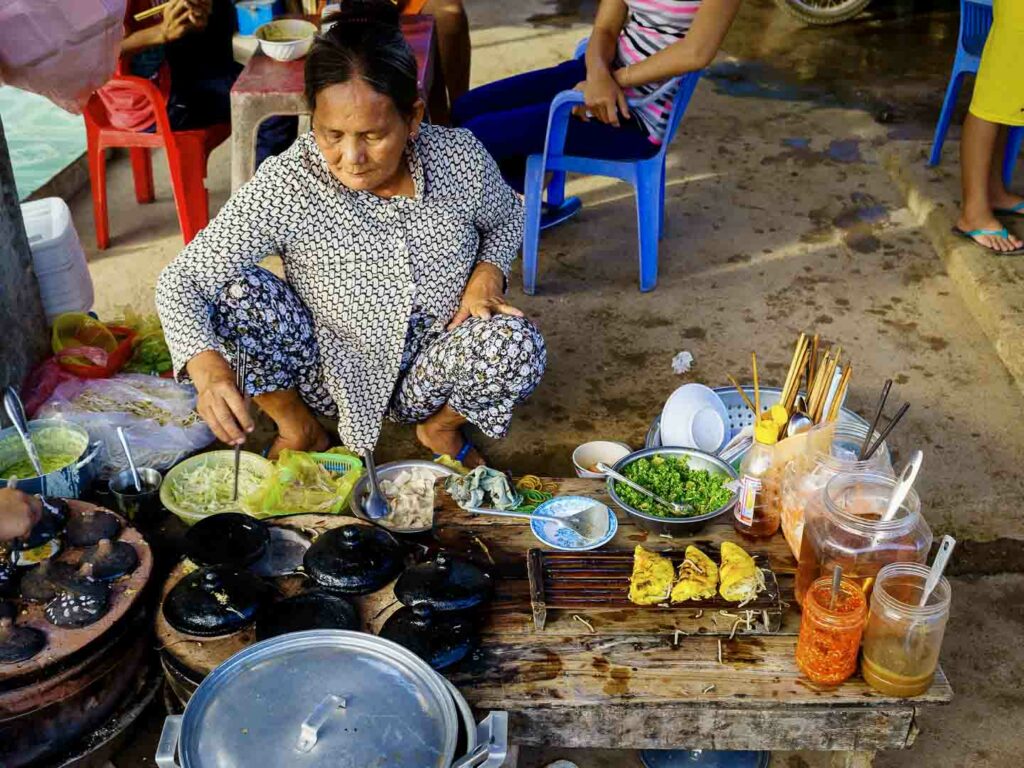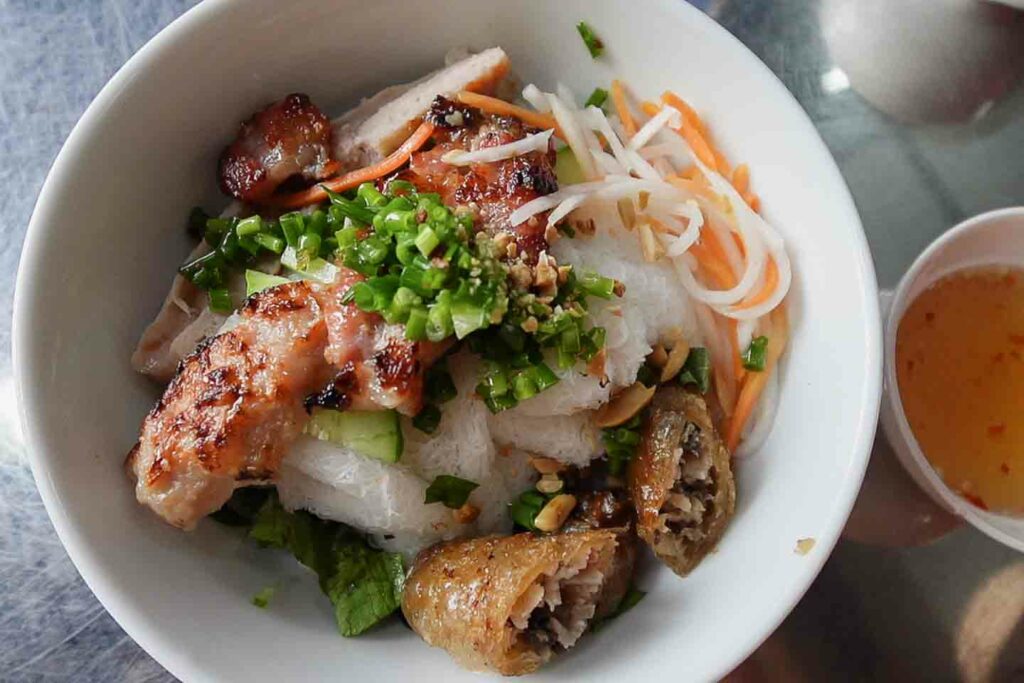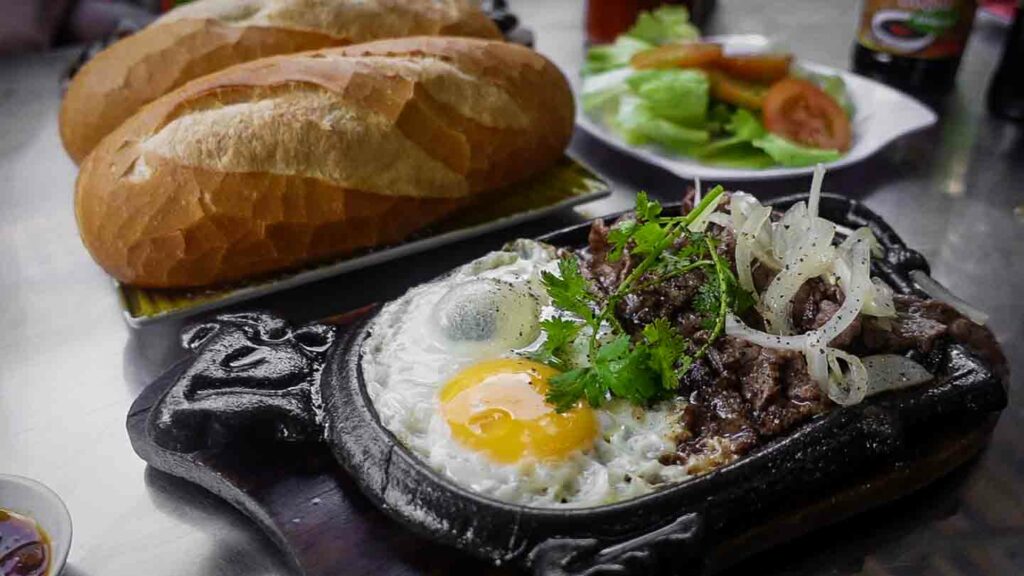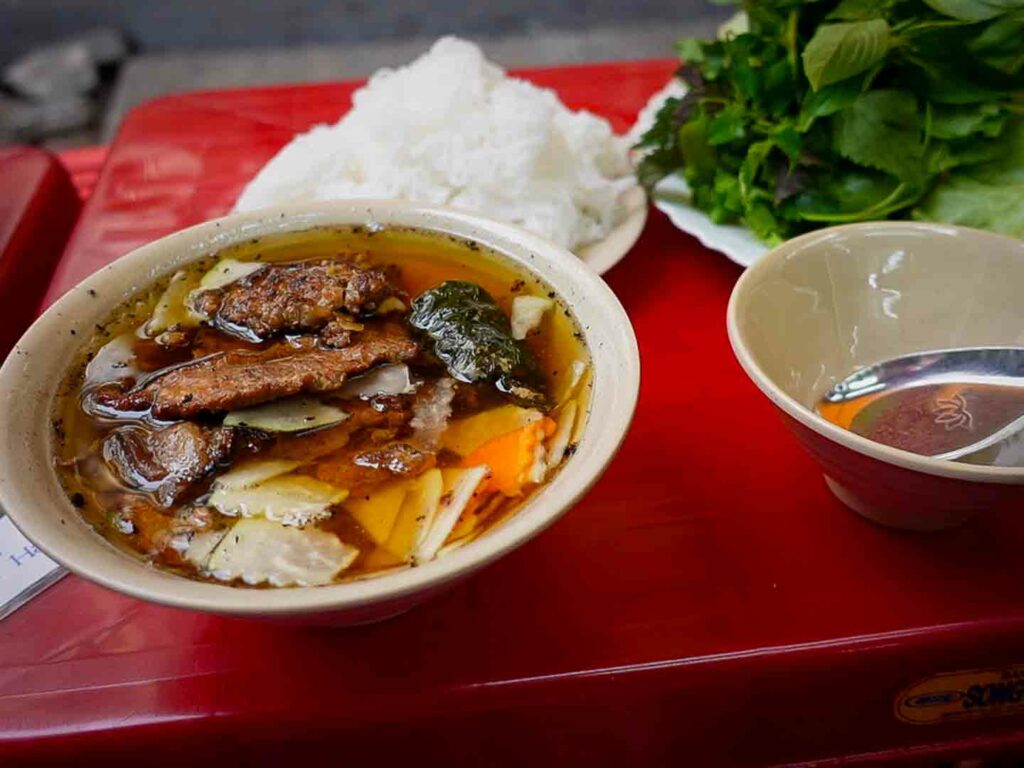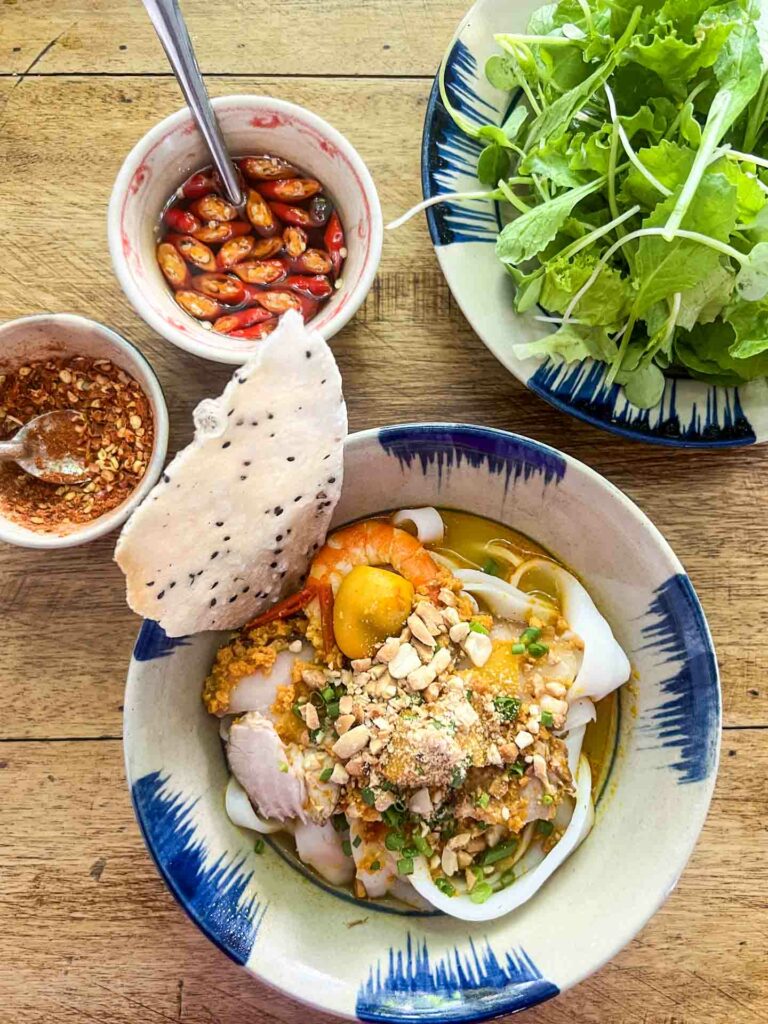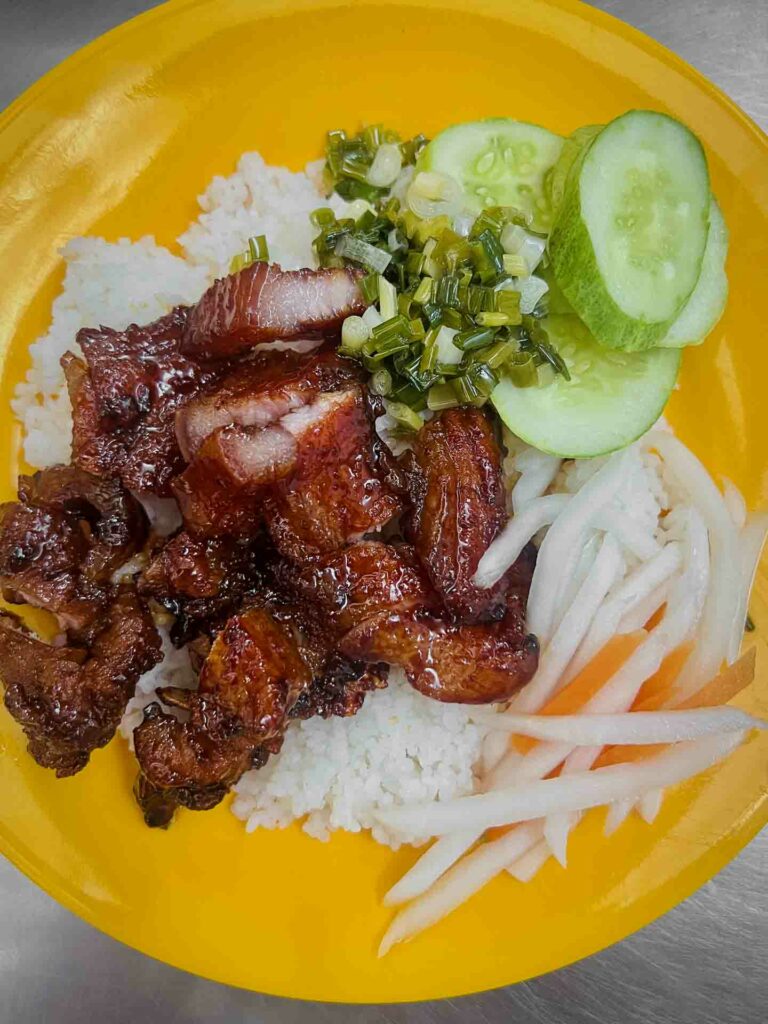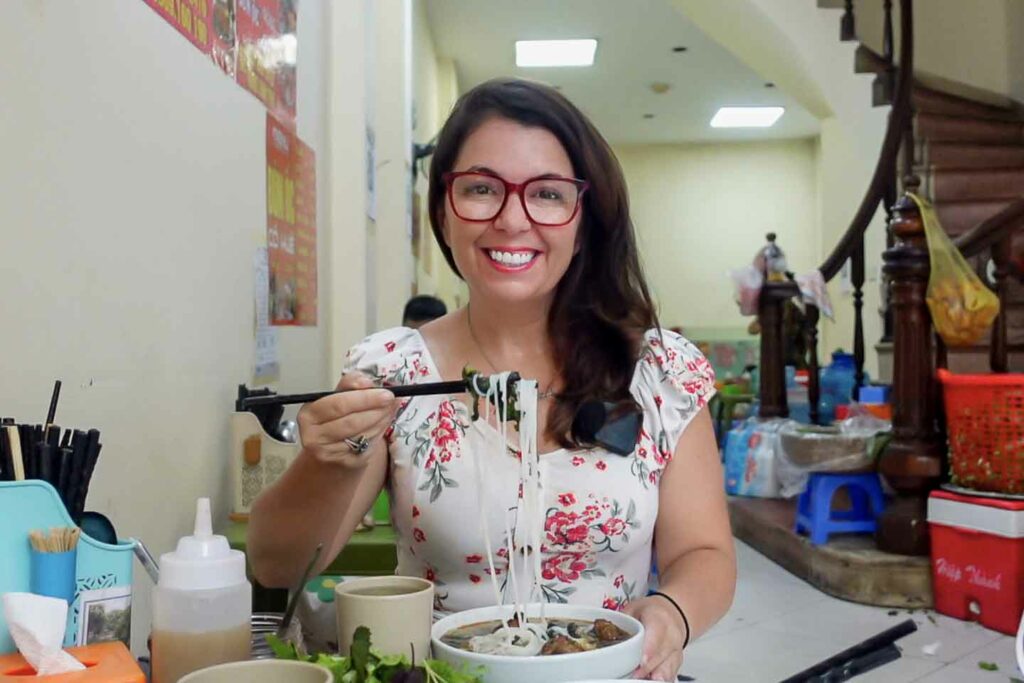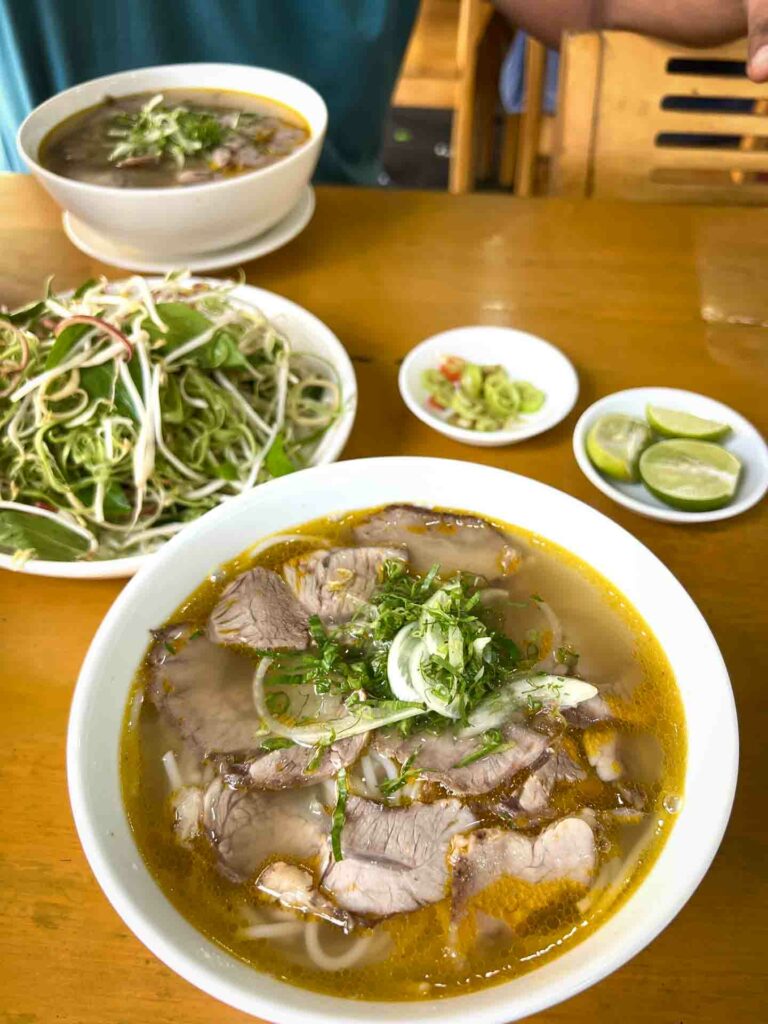Vietnamese breakfast dishes are so delicious even if you’ve never been a morning person you’ll become one.
Forget everything you know about breakfast. In Vietnam, the first meal of the day isn’t cereal or toast. It’s a warm bowl of bun cha at 7 AM or fresh rice rolls that melt in your mouth.
Vietnamese breakfast culture revolves around fresh ingredients, complex flavors and dishes that keep you satisfied for hours.
Most Vietnamese people eat breakfast between 6-8 AM, often grabbing a quick bowl from street vendors before work. The food is light but filling, designed to fuel you through a busy morning without weighing you down.
What makes Vietnamese breakfast special is the balance.
Sweet, sour, salty and umami flavors dance together in every dish. Fresh herbs brighten heavy broths. Crispy textures contrast with silky noodles in Vietnam.
It’s food that wakes up all your senses.
Vietnam Culinary Influences
Vietnamese breakfast dishes reflect the country’s complex history and geography. Chinese influence appears in congee and noodle soups.
French colonialism brought baguettes that became bánh mì. Indigenous ingredients like fish sauce, lime and fresh herbs create the distinctive Vietnamese flavor profile.
The tropical climate shaped eating habits too.
Light broths and fresh vegetables help people stay cool in humid weather. Hemi quanrbs like mint, cilantro and basil aren’t just garnishes. They’re essential ingredients that add cooling properties and aid digestion.
Regional differences matter in Vietnamese breakfast culture.
Northern dishes tend to be more subtle and less sweet.
Southern Vietnamese food embraces bold flavors and more sugar.
Central Vietnam falls somewhere between, with funky fermented flavors that balance heat and complexity.
Must Try Vietnamese Breakfast Food
These dishes represent the heart of Vietnamese breakfast culture. Each one tells a story about the region it comes from and the people who perfected it over generations.
Grilled Pork Vermicelli Bowl | Bún Thịt Nướng
This southern Vietnamese breakfast combines rice vermicelli noodles with grilled pork, fresh herbs and vegetables. The dish includes pate, spring rolls and pickled vegetables, all served with fish sauce for dipping.
The contrast of textures makes this dish special. Soft noodles, crunchy vegetables, crispy spring rolls and tender pork create a satisfying mix. The fish sauce adds that essential umami depth that Vietnamese cuisine is known for.
Bún thịt nướng originated in Ho Chi Minh City and spread throughout southern Vietnam. Street vendors serve it from early morning until noon, making it perfect for breakfast or lunch.
Where to Eat Bún Thịt Nướng: Bún Thịt Nướng Hằng
27 Yersin, Cau Ong Lanh Ward , District 1 , HCMC, Vietnammi
Night Market in Phu Quoc
Sticky Rice with Mung Bean | Xôi Xanh
Yellow sticky rice steamed with mung beans and coconut milk. The rice is naturally colored with turmeric and has a slightly sweet, nutty flavor that’s incredibly satisfying.
The mung beans add protein and a different texture to the chewy sticky rice. Coconut milk provides richness without being too heavy for morning eating.
This northern Vietnamese breakfast shows Chinese influence on local cuisine. Sticky rice dishes are common throughout Asia, but each region develops its own variations.
Some vendors top it with crispy fried shallots or pork floss for extra flavor and texture. It’s often wrapped in banana leaves for portable eating.
Where to Eat Xôi Xanh: Traditional breakfast vendors in Hanoi’s Old Quarter Look for vendors with large steamers displaying different colored sticky rice varieties
.Vietnamese Steak and Eggs | Bò Né
Marinated skirt steak sizzles on a cast iron pan alongside fried eggs and fresh bread. The name means “dodging beef” because the hot oil spatters and you need to dodge it while eating.
The beef is incredibly tender despite being a tough cut. Vietnamese cooks marinate it in fish sauce, garlic and other aromatics that break down the fibers. The result is steak that practically melts in your mouth.
This dish shows French influence on Vietnamese cuisine. The bread and eggs reflect colonial impact, but the marinades and cooking techniques are purely Vietnamese.
Where to Eat Bò Né: Traditional Vietnamese restaurants in Ho Chi Minh City’s District 1 Look for places with cast iron pans visible from the street
.Hanoi Pork and Noodle Soup | Bún Chả
Grilled fatty pork and minced pork meatballs swim in a sweet, salty broth. Rice noodles and fresh herbs come on the side. You create small portions in your bowl, mixing noodles, meat, herbs and broth.
The broth is what makes bún chả special. It’s light but intensely flavorful, with a sweetness that appeals to Western palates. The grilled pork adds smokiness while herbs provide freshness.
This is Hanoi’s most famous traditional dish. It represents northern Vietnamese cooking, which tends to be more subtle than southern food but equally complex.
Where to Eat Bún Chả: Bun Cha Huong Lien
24 P. Lê Văn Hưu, Phan Chu Trinh, Hai Bà Trưng, Hà Nội, Vietnam
Hanoi Street Food
Duck Embryo with Herbs | Trứng Vịt Lộn
A partially developed duck embryo boiled and eaten with Vietnamese mint, salt and lime. This protein-rich breakfast is considered a delicacy and aphrodisiac in Vietnamese culture.
The texture combines the softness of a hard-boiled egg with more developed flavors. Fresh herbs and acidic lime cut through the richness while salt enhances the natural flavors.
This dish originated in northern Vietnam but spread throughout the country. Street vendors sell it from small carts, often with other egg-based snacks.
Many visitors find this challenging, but it’s completely normal breakfast food for Vietnamese people. The key is eating it with all the accompaniments, not plain.
.Central Vietnamese Thick Noodle Soup | Mì Quảng
I first discovered these noodles in Hoi An. And to this day they are my favorite.
Thick rice noodles swim in a rich broth with shrimp, pork and quail eggs. The dish comes with fresh herbs, lime and rice crackers that add crunch. The broth has a distinctive color from tumeric.
The noodles are what set mì quảng apart. They’re much thicker than typical Vietnamese rice noodles, almost like fresh pasta. The texture holds up well in the rich broth.
This dish originated in Quang Nam province in central Vietnam. It’s the regional specialty that locals eat for breakfast and lunch. The recipe varies by family, but always includes the signature thick noodles.
Pineapple juice adds subtle sweetness to the broth instead of sugar. This creates a more complex flavor that develops as you eat.
Where to Eat Mì Quảng: Mi Quang 92
112A Đ. Trần Cao Vân, Phường Minh An, Hội An, Quảng Nam, Vietnam
Steamed Rice Rolls | Bánh Cuốn
Thin sheets of steamed rice paper wrap around pork, wood ear mushrooms and crispy shallots. The rolls are silky smooth and incredibly delicate.
They’re served with fresh herbs and a dipping sauce made with fish sauce, lime and chili.
The texture is what makes bánh cuốn magical. The rice paper is so thin it’s almost translucent, but strong enough not to tear. Inside, the filling provides textural contrast with chewy mushrooms and crispy shallots.
This dish requires serious skill to make properly. Cooks spread rice batter on cloth stretched over boiling water, creating the thinnest possible sheets. It’s an art form that takes years to master.
Where to Eat Bánh Cuốn: Traditional breakfast spots in Hanoi Look for places where you can see them making the rice sheets fresh
.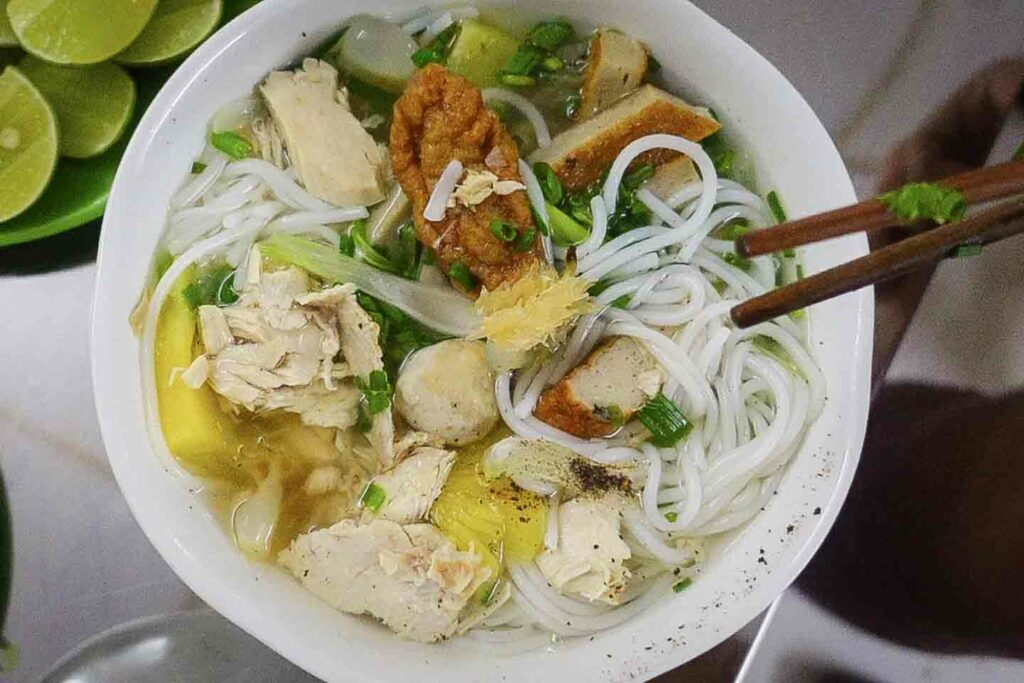
Fish Noodle Salad | Bún Mắm
Cold vermicelli noodles mix with fish sauce, fish cake, squid, jellyfish and pineapple. The dressing is intensely flavorful with sweet, sour, salty and umami notes all competing for attention.
The fish sauce dressing is what makes this dish unique. It’s not just regular fish sauce but a specially prepared version that’s been fermented longer and mixed with other ingredients.
This Mekong Delta specialty showcases the region’s abundant seafood. The jellyfish adds an unusual texture that’s crunchy and slightly bouncy.
Most foreigners find this dish challenging at first because of the strong fish flavors. But locals consider it one of the most sophisticated Vietnamese salads.
You can also find a similarly named Da Nang food called bun mam nem, which is different but equally delicious with funky fermented paste.
Where to Eat Bún Mắm: Can Tho and other Mekong Delta cities Street vendors near the floating markets serve the most authentic versions. In Saigon Bún Mắm Abc, 13 Đ. Ngô Tất Tố, Phường 19, Bình Thạnh, Hồ Chí Minh, Vietnam
.Broken Rice with Grilled Pork | Cơm Tấm
Broken rice grains top with grilled pork, pickled vegetables and fish sauce. The rice has a different texture than regular rice because the grains are literally broken during processing.
The pork is marinated in fish sauce, sugar and aromatics, then grilled over charcoal. The result is incredibly tender meat with crispy edges that locals call “pork candy.”
Broken rice was originally considered poor people’s food because it was cheaper than whole grain rice. Now it’s a beloved specialty throughout southern Vietnam.
The dish represents Vietnamese resourcefulness. Nothing gets wasted, even broken rice grains that couldn’t be sold as premium product.
Where to Eat Cơm Tấm: Street stalls throughout Ho Chi Minh City District 1 has many family-run stalls that have served the same recipe for decades
Vietnamese Fruits
Fish Ball Soup | Bánh Canh Cá
Thick tapioca noodles in clear fish broth with handmade fish balls and fresh herbs. The noodles are almost translucent and have a unique chewy texture completely different from rice noodles.
The fish balls are made fresh daily from local fish, creating a bouncy texture that’s both fun and satisfying to eat. The clear broth lets the fish flavors shine through.
This central Vietnamese specialty originated in fishing communities where fresh fish was abundant. The tapioca noodles were easier to make than wheat noodles in the tropical climate.
Where to Eat Bánh Canh Cá: Fishing villages throughout central Vietnam Phan Thiet and Mui Ne have some of the best versions near their fishing ports
.Snail Noodle Soup | Bún Ốc
Vermicelli noodles float in a light tomato broth with two types of snails and fish cakes. The broth is sweet and sour, brightened with fresh herbs and customizable with various condiments.
The snails are the star ingredient. Vietnamese cooks prepare them with lemongrass and ginger to remove any muddy taste. The result is tender, flavorful protein that tastes like the ocean.
This Hanoi specialty showcases the city’s love for snails. You’ll find snail dishes throughout northern Vietnam, but bún ốc remains the most popular breakfast version.
Where to Eat Bún Ốc: Local breakfast spots throughout Hanoi Ask your hotel or tour guide for recommendations since these places aren’t usually in guidebooks
.Hue Style Beef Noodle Soup | Bún Bò Huế
Thick rice noodles swim in a spicy beef broth with lemongrass and chili oil. The soup traditionally includes pork knuckle and Vietnamese sausage, but many places will make it without pork if requested.
The broth is more complex than pho, with layers of flavor from lemongrass, annatto seeds and fermented shrimp paste. It has a distinctive red color and spicy kick that wakes you up in the morning.
This central Vietnamese specialty originated in the former imperial capital of Hue. The complex flavors reflect the sophisticated court cuisine that developed there.
Where to Eat Bún Bò Huế: Vietnamese restaurants throughout major cities Central Vietnam has the most authentic versions, but good versions exist nationwide
Vietnamese Fruits
Oyster Rice Porridge | Cháo Hàu
Creamy rice porridge topped with fresh oysters, black pepper, chili and chives. The porridge has the consistency of thick soup and provides comfort food satisfaction.
The oysters are added at the end so they stay tender and briny. They provide a pop of ocean flavor that contrasts beautifully with the mild rice base.
This is Vietnam’s version of congee, the rice porridge found throughout Asia. Each country has its own variations, but the Vietnamese version tends to be less thick than Chinese congee.
I first tried it outside the Dalat Night Market. Street vendors serve this throughout the night and into early morning, making it popular with late night workers and early risers.
Where to Eat Cháo Hàu: Night markets and early morning street stalls Best found near fishing ports where the oysters are freshest
Tips for Eating Your Way Through Vietnam
- Vietnamese breakfast happens early. Most street vendors start serving around 6 AM and many popular dishes sell out by 10 AM.
- Don’t expect English menus at the best places. Use Google Translate’s camera function to read Vietnamese menus, or better yet, point at what other people are eating.
- Always eat the fresh herbs. They’re not just garnish but essential parts of each dish. Vietnamese cuisine balances hot, sweet, sour and salty flavors, and the herbs provide the cooling element that makes everything work together.
- Most Vietnamese people aren’t vegetarian, but Buddhist influence means many dishes can be made without meat. Fish sauce appears in most dishes, so strict vegetarians should learn to ask for vegetarian versions in Vietnamese.
